The Hive Reads… The Ninth Rain by Jen Williams
Welcome to the fourth instalment of our ‘Hive Reads’ feature! (You can read the others here.) After settling on The Ninth Rain by Jen Williams as our April read, a bunch of us here at the Hive diligently noted down our thoughts whilst reading throughout the month. You can read the end result below! Though do beware: potential spoilers abound.
This month’s read is brought to you by the fabulous team of Alicia Wanstall-Burke, T.O. Munro, T L Greylock, G.D. Penman, Beth Hindmarch and Laura M. Hughes.
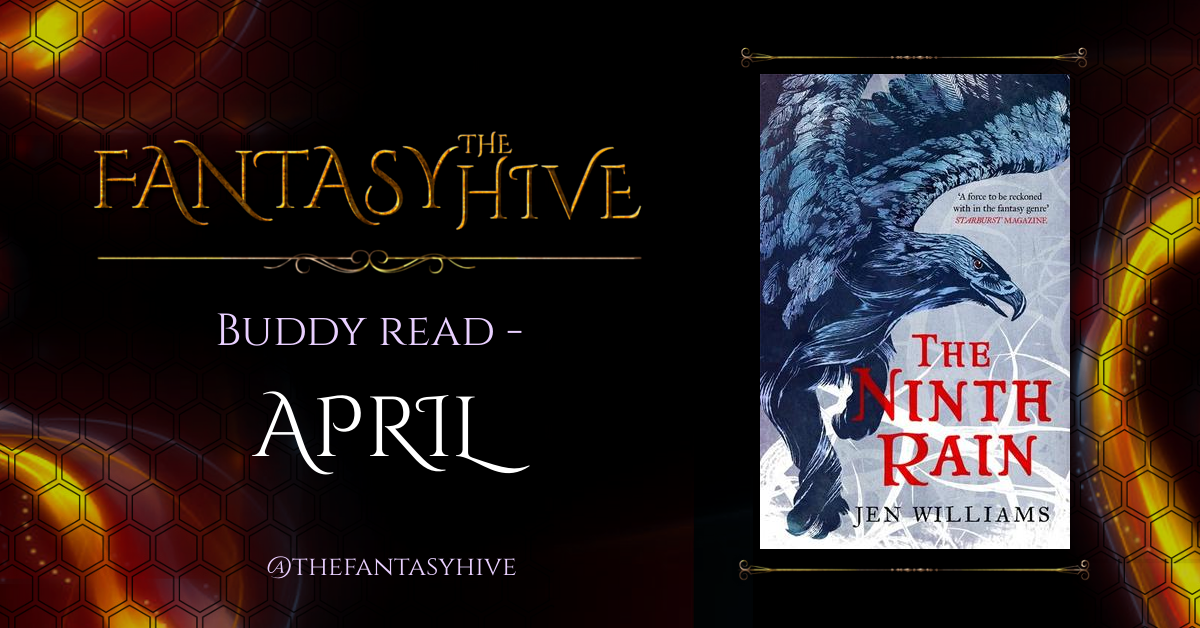
Laura M. Hughes: Welcome, everyone, to the latest Hive Read! This time we’re getting stuck in to The Ninth Rain by Jen Williams, which I believe everyone has thoroughly enjoyed. First things first: first impressions. What do we all think about the cover?
Beth Hindmarch: I like the cover, you can’t go wrong with a great big gryphon gracing the cover. It’s undeniably eye catching. But it is a little misleading as there isn’t a gryphon in the book… a giant bat would have been great!
G.D. Penman: The cover is gorgeous, but it really doesn’t give much away, does it? Looking at that cover you might expect a perfectly “normal” fantasy book, when in fact it revolves around alien invasions, terraforming, archaeology and a metric ton of ancient mysteries.
Laura: Agreed, G.D.! Having previously read Jen Williams’ The Copper Promise, I was expecting more of the same traditional adventure fantasy. The Ninth Rain threw me right off – in the best possible way.
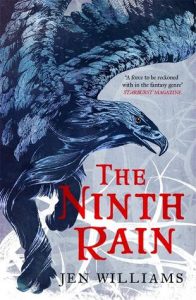
Taya (T L Greylock): I actually think the cover does the book a disservice. I suppose there’s merit to keeping the cover fairly neutral, but as Laura said, the art suggests traditional and clearly that’s not what we have here. I’d love to see a really unique cover that ties to the story without giving anything away. No idea what that looks like, but it’s got to be doable.
Laura: Good point, Taya. Perhaps if the books are ever released in the US they’ll go for something a bit different. Only time will tell…
Let’s move on to the characters. Did anyone have a favourite? What did we all think about the cast and their relationships with each other, and with the world?
T.O. Munro: This is a complex world with distinctive characters. Four main points of view, of which three are female – a ratio after my own heart – plus another couple of minor PoVs which may develop as we go on.
First there’s Tor the Eboran in exile, sell-sword with quite a sword to sell, talented, dashing, humorous and also desperately, lonelily human. Reminds me a bit of Inigo Montoya from The Princess Bride.
Then there’s Vintage, the woman with a fortune built on wine and a world of curiosity to spend it on – a kind of archaeologist/scientist adventurer in the tradition of Indiana Jones, Quatermass or Lara Croft – though more grounded, more people-focused than any of those.
There’s also Hestillion, a woman who can walk in and out of people’s dreams, the last guardian of a decayed and broken empire coughing its way into bloody oblivion.
Finally, there’s Noon, a witch who can steal people’s life force by a touch on bare skin and turn it into fire, a power for which she is incarcerated in an island prison by sadistic nuns (compared to them, those who used to run the worst of the Magdalene laundries look like saints). Yet Noon somehow survives in body and spirit.
Laura: Who was your favourite?
T.O.: The strength of the writing shows in that I didn’t really have a favourite. I love them all, never sorry to pick up the thread and the thoughts of one of them, never in a hurry to drop one character and return to another.
Alicia Wanstall-Burke: I wanted to punch Hest in the face by the end of the prologue and her subsequent chapters left me hoping she’d get her eyeballs burnt out by her poor long-suffering cousin.
Laura: Don’t sit on the fence, Alicia. Say what you really think…
Alicia: She’s so fucking RUDE!!! I’m sure that’s entirely intentional on the part of the esteemed author, and it works
T.O.: Mind you, she was always pretty rude from the outset in the two prologues. Never a very welcoming host!
G.D.: I am starting to worry that I may have some sort of character flaw, because I really love Hest. She hasn’t got her brother’s self-involved charisma, Noon’s eternal flame of snark or Vintage’s heart, but she is a nasty manipulative egotist who wants to save the entire world, but only if she gets all the credit… how can you people not love that?
Laura: She’s definitely one of the most entertaining POVs I’ve come across, I’ll give her that! Alicia, were there any characters whose eyes you didn’t want to burn out?
Alicia: Tor and Vintage are a fucking joy! Their banter is just perfect! The later snark between Noon and Tor is even better.
The narrative flows along really nicely between the four different POV characters at the start – it isn’t jarring to move between them as the narrative shifts at logical points. You are being moved through time quite quickly between the chapters (across some 200 years) but it feels smooth. You really WANT to keep reading.
Taya: I didn’t find the passage of all those years quite as smooth, but in hindsight, it works. At the time, I found myself thinking that I didn’t want to be bothered to keep track of what happened 50 years ago vs. what happened 200 years ago. However, once we got into the book properly–namely when Vintage came into her own in her first true chapter–I was hooked. As for the name Vintage–pure gold. Sometimes it’s painfully obvious when authors want to give their characters cool nicknames, but this one flat-out works. Kudos to Jen for nailing it. And as Alicia says, the relationship between Vintage and Tor is wonderfully depicted. We know from the moment we see them on the page together that their relationship is one of depth, time, trust, and friendly exasperation.
“The relationship between Vintage and Tor is wonderfully depicted. We know from the moment we see them on the page together that their relationship is one of depth, time, trust, and friendly exasperation.”
– T L Greylock
Alicia: I absolutely adore Vintage’s voice — her dialogue is so real, I can hear every inflection and emphasis. That’s also true of all the characters, but Vintage just has this unique sound that is truly wonderful. I think this is a great lesson in how to write dialogue without phonetically spelling out every uttered word exactly as the character says it. You can construct those sentences in such a way that the reader can ‘hear’ the voice or accent, while reading whole words. It’s really well done, I think.
T.O.: Yes, you’re right, the affectations in Vintage’s speech convey character and attitude without dropping into phonetic depiction of accent (a bit like Gatsby’s use of “Old Sport” as a motif says a lot about who he is – or who he is pretending to be).
G.D.: It is really rare to find a book where one character doesn’t jump out as a favourite because they are all so well developed and characterised. Having said that, every time I thought something bad was about to happen to Vintage, I was ready to throw the book across the room. While the other two had all their slightly vague supernatural powers to pull them back from the brink, she was the most human both in frailty and in motivation.
Aldasair also ended up being an unexpected favourite, clawing his way back to reality, although I did spend quite a lot of time with him towards the end of the book wishing he would just KISS BERN and put us all out of our misery. The whole book was a lot gayer than it looked from the outset, so that was a pleasant surprise.
Alicia: OMG when Aldasair and Bern were in the “secret place” I was like, *bangs fist on table* JUST KISS THAT ADORABLE AXE-WIELDING ROCK-VIKING ALREADY!!! Oh my poor heart!
Beth: Jen is a fantastic storyteller, is a convincing world builder; but her characters are absolutely her strength. They have incredible depths of humanity and ambiguity; and I feel she always does a great job of representing so many different groups of people. Her characters are so diverse.
“Jen is a fantastic storyteller, is a convincing world builder; but her characters are absolutely her strength. They have incredible depths of humanity and ambiguity; and I feel she always does a great job of representing so many different groups of people. Her characters are so diverse.”
– Beth Hindmarch
Although Vintage always seems to be a firm favourite (How can she not be? Sticking it to her patronising over-protective family and showing you don’t have to be a perky teenager to have adventures.), Noon was my favourite. I loved her story arc and progression, her drive to escape and the fact that, just like the rest of them, she still has her flaws.
Laura: I enjoyed Noon’s arc too, Beth. I especially liked how people’s attitudes toward fell witches was reminiscent of the treatment of mages in the Dragon Age franchise (which I know Jen is a huge fan of). When we first meet Noon, she’s basically trapped inside the worst Circle Tower imaginable, which just makes her throwing off the chains of oppression even more wonderful to read.
Speaking of beginnings: does anyone have any thoughts on structure and pacing within the novel? Did it hook you from the outset, or take a while to get going? We’ve already established that most of us (myself included) enjoyed the shifting POVs, but did they keep those pages turning all the way through?
T.O.: For me, the pace and structure are pretty much pitch perfect. The two opening flashbacks/prologues (200 years ago and 50 years ago) work efficiently to set the essential backdrop of the story. The italicised openings to each chapter drawn from the papers of Lady Vintage also help to entertainingly info-dump or bridge events in the story – e.g. how Vintage and Tor met up.
I never liked Drizzt Do’Urden’s italicised reminiscences in R.A.Salvatore’s Dark elf books–always skipped them. But here–though longer than, say, the chapter openings in Josiah Bancroft’s Senlin Ascends–I still find these reflections short and pithy enough to smooth the flow of reading rather than impede it.
Also, in some ways these openings hint at a dark framing story. Who is sorting/organising/editing Lady Vintage’s papers? Why are we told that one sample of the papers ends abruptly, the sheet having been torn off?
G.D.: Wasn’t it established that the little notes were being collected and catalogued by her favourite nephew? I may just be inferring?
Laura: I think so, though what T.O. says about one of them ending abruptly is certainly very ominous.
Beth: I was wondering who was collating the information too! I found it a clever device, when Vintage was in trouble it felt like there was really jeopardy, as we already know that at some point someone’s had access to what would normally be private documents…
Alicia: The journal entries and letters remind me of a device used in some of Robin Hobb’s books, which is quite comfortable and cozy and I will have some more of that, thank you.
Laura: I’ve always been a fan of epigraphs at the beginning of chapters, too. (Michael R. Fletcher’s Beyond Redemption utilises them really well, as does Heart of Stone by Ben Galley. And, of course, The Malazan Book of the Fallen by Steven Erikson.) The Ninth Rain is definitely one of the best examples of this I’ve read.
Alicia: Some of them have been a bit weighty at a point in the story where I want to get back to the action, but not so much that I’m like, ugh, I’m too tired for this. It makes me want to push on, and I know there is a little nugget of information hidden in each of them.
G.D.: The pacing worked really well for me, although I didn’t adore the distant prologues. I understand why they weren’t incorporated into the story as background material but it was still a tiny stumbling block before we got to the good stuff. Once we were into the POV chapters, I was sold. As everyone else is saying, you don’t resent spending time with a single character because each plotline is equally engaging. Not like some multi-POV fantasy stories where you just wish you could skip the Daenerys chapters entirely…
T.O.: Lol – mentioning no names there, G.D.!
Laura: He’s got a point, though. No one likes Daenerys’ chapters…
Taya: As I mentioned above, I’m definitely in agreement with Graeme about the prologues. I think it could have worked to jump right in to the POV chapters. That being said, I didn’t at all mind the continuation of Vintage’s notes to kick off each chapter.
G.D.: Structurally, I liked that the book had some jumping about rather than what a lot of authors seem to consider a natural progression. When new information presented itself, our characters split off to pursue their own interests, while still keeping the others in their thoughts. A lot of fantasy books would have been bound too much by the old tabletop gaming adage of “don’t split the party” but this book goes where it needs to go.
T.O.: There’s a bit where Agent Lin, in a moment of self-reflection, observes, “There were many advantages to being an agent of the Winnowry, but they mostly worked alone. This is what it led to: talking to bats.”
It had me thinking of the difficulty of stories/storylines pursued by just one character. How do you get essential dialogue into these situations? (That’s why, when I’m writing, I like two-handed scenes.) So in Castaway, Tom Hanks had to interact with a volleyball called Wilson, and there was a scene in one of the Hobbit movies where Gandalf discovers the Nazgul have broken out of their cell/tombs and has taken Radagast with him and Radagast/Sylvester McCoy asks “why am I here, Gandalf?” and I could feel the fourth wall cracking as I thought only so Gandalf has someone to talk/info-dump to.
So, too, Agent Lin has to talk to her bat.
G.D.: I suppose that is the one downside of this kind of limited third person perspective. Everything has to be externalised before it can be conveyed to the reader/viewer. You can’t just listen in on what they are thinking. They have to be constantly yammering.
Laura: True, and really interesting, too. Though I for one adored the bats.
T.O.: Giant bats ridden by witches! Gotta be a damn sight more comfortable than broom sticks.
Laura: For me, they were just one more (adorable) aspect of a fresh and exciting secondary world. Speaking of which: what are everyone’s thoughts about said world?
T.O.: Wow, just wow. What a world.
OK, the Eborans are basically elves.
Tall – check
Elegant – check
Beautiful/musical/talented in many ways – check (Tor might give Rothuss’s Felurian a run for her money in the bower department)
Long lived – check
Slightly remote/patronising attitude towards humans – check
Love/hug trees – check
Pointy ears – er … nope
Vampiric tendencies/fondness for human blood – er… OK, not strictly canonical elves, but still elves with a twist.
Alicia: But sexy elves, am I right? *wink wink*
T.O.: Sexy and yet so civilised. I love the way that Tor is obsessed with the finer things in life. Good silk shirts, vintage wine, aromatic cheese, and tea prepared with all due propriety. (OK, civilised apart from the Crimson War blood sucking thing.)
Alicia: He’s pretty much permanently on the verge of being completely shitfaced, which I imagine elves would turn their perfectly formed long-lived noses up at. Does one’s liver suffer the hardships of booze-houndery when one is as long lived as our Tor? Or can he be blotto most days and roll on with no problems? Whatever the answer, Tor is definitely the kind of guy you’d take with you to Vegas.
“[Tor is] pretty much permanently on the verge of being completely shitfaced, which I imagine elves would turn their perfectly formed long-lived noses up at. Does one’s liver suffer the hardships of booze-houndery when one is as long lived as our Tor? Or can he be blotto most days and roll on with no problems? Whatever the answer, Tor is definitely the kind of guy you’d take with you to Vegas.”
– Alicia Wanstall-Burke
Laura: Absolutely.
Any thoughts on the worldbuilding? For me, I love how original it feels, yet I find it really hard to describe to people who haven’t also read the book.
T.O.: A world blighted by waves of past alien invasions with one dead spaceship/behemoth in constant orbit as a corpse moon, and others buried as wrecks across the land leaking some corrupting taint into the soil.
Aliens that seem like some combination of the recurrent foe from Ender’s Game by Orson Scott Card, or Will Smith’s Independence Day, or the martians from War of the Worlds (like in the Tom Cruise film), where it was not just a war of conquest but a battle to terraform another people’s world.
Aliens who hollow out your nearest and dearest and turn them into shell-like automatons to serve in the alien army – like Invasion of the Body Snatchers meets The Walking Dead.
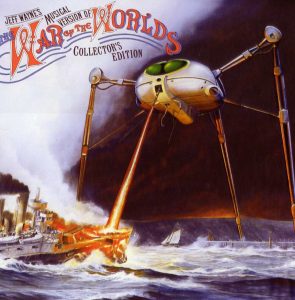
Laura: Okay, that’s actually an awesome summary of the world and its biggest external conflict. And dear god, the Jure’lia… I’m terrified of them.
T.O.: I can’t wait to meet these out-of-this-world monsters, and, judging by the dreams everyone is having, we shouldn’t have to wait too long.
Alicia: The alien ‘mothers’ remind me so much of War of the Worlds. Great spindly things that were on the cover of my high school art teacher’s record of the recording. We used to listen to it on his record player in the studio while we worked.
T.O.: Oh that music! The original 1980s. Great to draw/paint to – or write to!
As for the spaceships; those crashed behemoths feel like some combination of
a) wrecked Independence Day motherships

b) the sundered Titanic

c) the zygon quasi-organic spaceships in the Dr Who Loch Ness Monster adventure
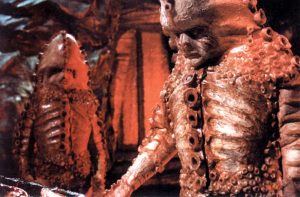
The whole thing also reminded me of an old AD&D module S3 Expedition to the Barrier Peaks, where magic and sci-fi mixed with wizards and warriors exploring the wreck of a crashed spaceship
Laura: I found it nearly impossible to compare to anything else, so I’m hugely impressed that you’ve managed to come up with so many great comparisons!
T.O.: I think G.D. summed it up very well on Twitter:
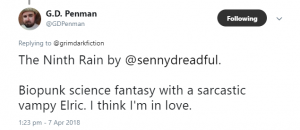
G.D.: I called it science-fantasy and I stick to that. There are scifi elements at the foundation of this book but they are presented entirely as “magical.” Even the supernatural coded Eborans can very easily be read as just another alien species, albeit one that arrived ahead of the Worm People to prevent their invasion; the whole set-up with their magical tree god feels like colonists who have forgotten what their ship’s AI is and have started worshiping it.
T.O.: Oooh! There is an exciting perspective.
G.D.: I absolutely love the biopunk elements of this book and the writing really emphasises just how gross organic technology would be, with a heavy emphasis placed on the insectoid nature of the Worm People to trigger the reader’s disgust.
Alicia: I do wonder though about the ‘varnish’-making slugs. They move very slowly, secreting a fluid that turns to a hard semi-transparent form soon after, something that I imagine is akin to amber. People are caught in the slime and stuck forever. But if they move really slowly, why don’t people get out of the way? Like, “Oh, look, there’s the slime beastie! Best we jog on before we get stuck in its leakage!”
Otherwise, the captured people stuck in the amber-slime are super creepy and I love it.
T.O.: “Jog on before we get stuck in its leakage” – sound advice! Slow-moving varnish should be easily escapable. But then I guess a fly could get trapped in amber, so if one foot got stuck then the stuff doesn’t have to flow that quickly to get the rest of you. But the varnish is creepy – a sort of translucent volcanic dust to create an even more erie Pompeii experience.
G.D.: The fact that both Eborans and Worm People have biotech that steps over the line into myth and magic is what really gave this book its own unique feel to me. There have been plenty of magic vs. science stories but I love the way that this one blurs that line so much that the sufficiently advanced technology truly is indistinguishable.
“The fact that both Eborans and Worm People have biotech that steps over the line into myth and magic is what really gave this book its own unique feel to me. There have been plenty of magic vs. science stories but I love the way that this one blurs that line so much that the sufficiently advanced technology truly is indistinguishable.”
– G.D. Penman
Even the Fell-Witches have taken the one clearly magical element of the story and industrialised it; turning the arcane powers of the chosen few into a production line for drugs.
There is a persistent problem in medieval fantasy with technology and its utter failure to advance over the millennia, but in this book there is at least a logical reason. Each of the previous eight Worm People invasions would have culled the human population and crippled progress. Even with those constant setbacks and the dangerous areas contaminated with fallout, it was quite exciting to realise that The Ninth Rain took place during Sarn’s Renaissance period rather than the dark ages.
Beth: I was not prepared for the world building. At all. I was not expecting spaceships and aliens at all. But likewise I was pleasantly surprised by the complexity of the society Jen created here, it felt like a big step up from The Copper Cat trilogy. I loved the dystopian elements; the institutionalised exploitation of the fell witches, their dehumanisation put me in mind of The Handmaid’s Tale. As G.D. pointed out, you so rarely read a fantasy where the world is on the brink of industrialisation, and I loved Jen’s approach to it here, her mix of magic and steampunk.
Laura: It’s an intoxicating mix, for sure. I said in my original review of The Ninth Rain that Jen’s hallmark is tropes with a twist. Here, she takes the traditional and filters it through her own imagination, then takes the unlikeliest aspects and combines them with the experimental skill and competence of an alchemist. The result? An eerily beautiful world, irresistably flawed characters, and an original, well-paced story.
General thoughts about the plot, anyone?
T.O.: The plot kept ticking over nicely. Within the looming threat of a world-engulfing apocalypse, the reader is still caught up in the individual struggles of the characters. The book does well at making the major into minor, the macro into micro. Tell me the world is in peril and I might be curious; show me a character whose fate I care about and I am invested.
“Within the looming threat of a world-engulfing apocalypse, the reader is still caught up in the individual struggles of the characters. The book does well at making the major into minor, the macro into micro. Tell me the world is in peril and I might be curious; show me a character whose fate I care about and I am invested.”
– T.O. Munro
I also like the foreshadowing that went on: meeting the Bitter Twins, and a fresco that Noon looked at which looks like it will lead nicely into the next book. 🙂
G.D.: The overarching plot, when you strip away the unique elements, is pretty straightforward. Ancient evil. Ancient good. Elder races in decline. But the depth of the characters, the uniqueness of the setting and the way that every element is examined rather than just accepted really elevate that simple plot into something much more interesting.
Beth: What struck me about the plot was that there was clearly going to be more than this one book could contain. I felt like it had been carefully crafted and planned as an introduction, yet driving enough to keep me interested and invested into the next book.
G.D.: I am a big fan of standalone books, or books from a series that you can read as a self-contained story, and thanks to the character arcs, this book can be read alone. There is obviously a big cliffhanger at the end, and this was very clearly just the first act of the overall story, but you don’t feel let down by the ending.
Also, I am so looking forward to the Hest/Jure’lia Queen snarkfest that is almost guaranteed to take over the sequel…
“Jen takes the traditional and filters it through her own imagination, then takes the unlikeliest aspects and combines them with the experimental skill and competence of an alchemist. The result? An eerily beautiful world, irresistably flawed characters, and an original, well-paced story.”
– Laura M. Hughes
Laura: I noticed some of you were noting down quotations during the readalong. Which ones in particular resonated with you?
T.O.: There were lots of lovely descriptive turns and phrases:
“…four scalpel-like towers that tore at the sky…”
“The daylight, already weak … had turned to a velvet darkness.”
“Hestillion closed her eyes, feeling her mind sink into the shadowy netherdarkness. It closed around her, as comforting to Hestillion as being held by a dear parent.”
Some of the descriptions make me wonder if the author does much gardening:
“Below, the dirt was black and exposed, riddled with pale roots grasping at air like skeletal fingers.”
“Three large fungi had fallen back, exposing their strange roots to the air like a drunken woman’s lacey skirts.”
And then this that made me smile:
Tor winked at her. “Worry not, my sweet. What is out there holds no fears for an Eboran warrior and his fabled sword.”
“I’m sure the girl has heard quite enough about your fabled sword for one evening.”
(I do love a knob gag!)
“We have a pact under the auspices of the House of the Long Night” = Eboran for “We are friends with benefits.”
Alicia: *snort*
I have so many favourite lines, but this one got me tonight, care of my new mate, Tor:
“Judging by the constellations just starting to glint into life, the scent of the wind and the texture of the earth…I would say we’re precisely in the middle of nowhere.”
T.O.: There are so many lovely turns of phrase and evocative descriptions. Whole pages of elegant prose and snippets to smile at.
“… a part of Mushenska known as the Downs, a shady and disreputable gang of streets …”
“The old man’s eyes were lost in wrinkles.”
“…pieces of the dream speeding away like leaves on the river…”
“…just the half-hearted wind for company.”
Another reason to like Bern the Younger (besides the fact that he is so kind to Aldasair and good with children and has two axes and – in my mind’s eye – looks like Thor played by Chris Hemsworth) – he has this perfect quote:
“Show me a people who don’t have a bloody history”
Another quote for our times in the constant social media-fuelled competition to define “other” as “evil.”
Alicia: Eeek! Yes! Hemsworth! *bites lip*
Beth: GET BACK ON YOUR BAT AND FUCK OFF. Seriously, I’m going to get that on a doormat, on a mug, in needlepoint hanging in the bathroom…
I found Jen’s language and prose gorgeous, another example of how her writing has progressed and improved. There were beautiful descriptions, her world was so easy to visualise, yet I never felt bogged down.
Laura: I felt the same, Beth. And I loved that there were laugh-out-loud quotes as well as more deep/poignant ones.
Finally, does anyone have any recommendations for books similar to The Ninth Rain?
T.O.: Hard to say, but the strangeness of its setting – the aftermath of recovery from a world-changing invasion by incomprehensible aliens with a mix of magic and technology – puts me a little in mind of Peter Newman’s The Vagrant trilogy.
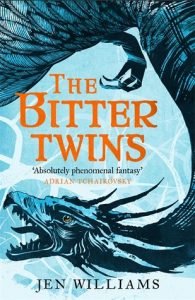 Alicia: Definitely The Vagrant, but let’s be honest, the best book to follow this up with is THE SEQUEL!! I am so keen for The Bitter Twins. It’s in the post, trucking its way across the country to me, because I live in the middle of nowhere with no book stores and I’m a hard copy book snob.
Alicia: Definitely The Vagrant, but let’s be honest, the best book to follow this up with is THE SEQUEL!! I am so keen for The Bitter Twins. It’s in the post, trucking its way across the country to me, because I live in the middle of nowhere with no book stores and I’m a hard copy book snob.
T.O.: Handily, the kindle version of The Ninth Rain includes a sneak preview of The Bitter Twins!
Alicia: I was packing our garden shed into a trailer today, and found myself carrying the wood axe and the log splitter. Then I started kind of sauntering across the yard thinking, ‘Oh, look at me with my Bitter Twins!’
…this is what my life is now, you guys…
G.D.: For a classic with a similar feel, I have to point to Moorcock’s “Elric” stories. Ebora is so closely aligned with the ancient and crumbling city-state of Melnibone, right down to the flying mythical creatures that once roosted there but are now in decline, that I find it difficult to believe it wasn’t deliberate. Tormalain the Oathless, with his mythical named sword, over-attachment to a close family member and self-indulgent attitude to the dubious “pleasures” of the world outside is basically Elric updated for a modern audience. It shows how much storytelling has evolved in the genre that he isn’t the sole lead of this book. He would definitely qualify as an aspect of Moorcock’s Eternal Hero, if nothing else.
For more modern books that handle the science-fantasy aspects of the book in a similar way – viewing the science through the lens of fantasy – I have to point to Sapkowski’s “Witcher” series, which has wizards alternating between discussing arcane secrets and Darwinian evolution without batting an eyelid. I also want to point people towards the amazing “Wings Unseen” by Becca Gomez Farrell; which was very much a classic fantasy setting that someone had dumped a scifi/thriller monster in the vein of Michael Crichton into. It also had a Hest-type character that I loved and everyone else hated… I am noticing a theme here.
Laura: Some really interesting recommendations here. As you know, The Vagrant is a Hive Read later this year, so it’ll be fascinating to see just how it compares with The Ninth Rain.
That’s it for this month! Thanks again to our wonderful reading team of Alicia, T.O., G.D., Beth, Taya and Laura (me). Be sure to drop by soon to see what we (and others) have to say about Kings of the Wyld by Nicholas Eames!
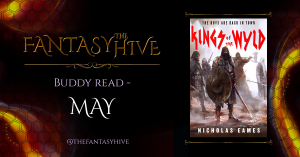
Bonus content: snippets and ‘thought farts’ from throughout the readalong!
T.O.: 40% in and just hit a “oooh” moment – So tell me, Alicia, has Hestillion been doing what I think she’s been doing and is that why you are in eyeball burning mode?
Alicia: I’m not telling!! But she’s so fucking RUDE!!! I’m sure that’s entirely intentional on the part of the esteemed author, and it works
T.O.: she was, she was, she was doing it! Mind you she was always pretty rude from the outset in the two prologues. Never been a great/welcoming host!
Alicia: *cough* I’m shipping Noon and Tor pretty hard right now, guys. I need a moment…
Alicia: (random thought farts)
– This needs to be a movie.
– Agent Lin – I do not like her
– Hest – Manipulative little shit
– Oooooh I think I know what the parasite spirits are!!!!
Taya: I’m at 17% and I have two thoughts:
- We are riding a giant bat.
- These are parasite spirits:
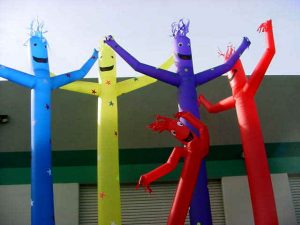
Alicia: I spent the entire time thinking of B.O.B.
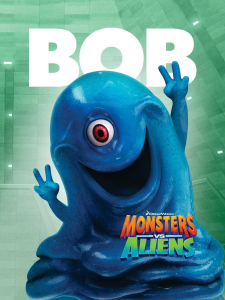
T.O.: Ah ha – I think I am getting ideas about the parasitic spirits too! Thoughts coalescing around the 60% mark and then Noon’s little moment of madness is tapping into more clues. So, let us examine the clues:
#1 they seem to occur around/near wrecked and/or recently unearthed behemoths
#2 that’s all I’m saying at the moment…
#3 I was right! – now read the book.

[…] Winnowing Flame Trilogy (right?). If you haven’t been paying attention, the fantastic first book, The Ninth Rain, won the British Fantasy Society award for best fantasy novel. With that novel announcing […]